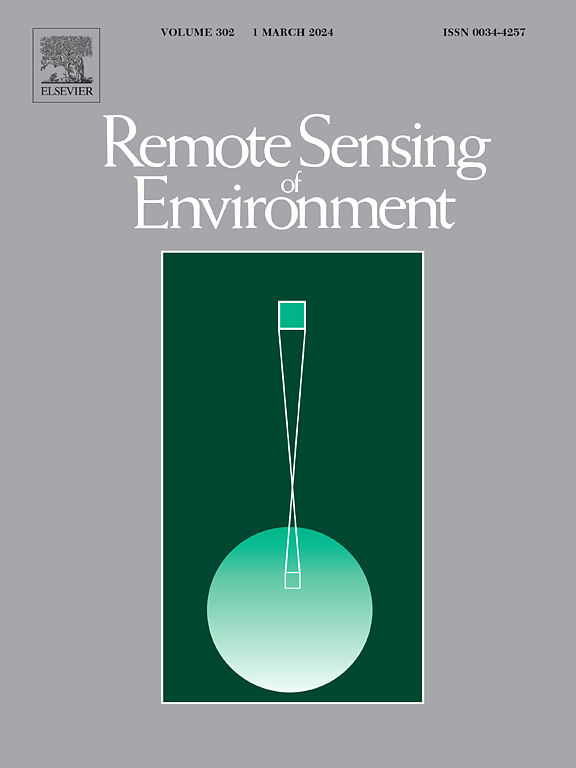Analytical modeling and correction of the ocean colour bidirectional reflectance across water types
IF 11.4
1区 地球科学
Q1 ENVIRONMENTAL SCIENCES
引用次数: 0
Abstract
The remote-sensing reflectance () varies with the illumination and viewing geometry, an effect referred to as anisotropy, bidirectionality, or bidirectional reflectance distribution function (BRDF). In the aquatic environment, bidirectionality arises from the anisotropic downwelling illumination, scattered by water and particles in varying proportions as a function of the scattering angle, and modulated by the two-way interaction with the sea surface. For remote sensing applications, it is desirable that the reflectance only depends on the inherent optical properties (IOPs). This process implies transforming into a “corrected” or “normalized” , referred to the sun at the zenith and the sensor zenith angle at the nadir. A recent review study (D'Alimonte et al., 2025) compared published BRDF methods, showing the better performance of that developed by Lee et al. (2011, henceforth L11) with respect to those proposed by Morel et al. (2002) and Park and Ruddick (2005). This article presents a new method starting from L11's analytical framework, named O25 after OLCI, the Ocean Colour sensor on Sentinel-3 satellite. O25 has been calibrated with a recently published synthetic dataset tailored to its needs (Pitarch and Brando, 2025). A comparative assessment using the same datasets as in D'Alimonte et al. (2025) concludes that O25 outperforms L11 and hence all pre-existing methods. O25 includes complementary operational features: (1) applicability range, (2) uncertainty estimates, and (3) a demonstrated reversibility of the bidirectional correction. O25's look-up tables are generic to any in situ and satellite sensors, including hyperspectral ones. For sensors such as Landsat/Sentinel 2, the IOPs retrieval component of O25 can easily be reformulated.
不同水系海洋颜色双向反射率的分析建模与校正
遥感反射率(RrsRrs)随光照和观测几何形状而变化,这种效应称为各向异性、双向性或双向反射率分布函数(BRDF)。在水生环境中,双向性来自于各向异性的下行照明,被水和粒子以不同比例散射,作为散射角的函数,并被与海面的双向相互作用调制。对于遥感应用,希望反射率仅取决于固有光学特性(IOPs)。这个过程意味着将RrsRrs转换为“校正”或“归一化”的rrrs,NRrs,N指的是天顶处的太阳和最低点处的传感器天顶角。最近的一项综述研究(D'Alimonte et al., 2025)比较了已发表的BRDF方法,结果显示,与Morel et al.(2002)和Park and Ruddick(2005)提出的方法相比,Lee et al.(2011,以下简称L11)开发的BRDF方法性能更好。本文提出了一种从L11的分析框架出发的新方法,以哨兵3号卫星上的海洋颜色传感器OLCI命名为O25。O25已使用最近发布的根据其需求量身定制的合成数据集进行校准(Pitarch和Brando, 2025)。使用与D'Alimonte等人(2025)相同的数据集进行的比较评估得出结论,O25优于L11,因此优于所有已有的方法。O25包括互补的操作特征:(1)适用范围,(2)不确定性估计,(3)双向校正的可逆性。O25的查找表适用于任何原位和卫星传感器,包括高光谱传感器。对于像Landsat/Sentinel 2这样的传感器,O25的IOPs检索组件可以很容易地重新制定。
本文章由计算机程序翻译,如有差异,请以英文原文为准。
求助全文
约1分钟内获得全文
求助全文
来源期刊

Remote Sensing of Environment
环境科学-成像科学与照相技术
CiteScore
25.10
自引率
8.90%
发文量
455
审稿时长
53 days
期刊介绍:
Remote Sensing of Environment (RSE) serves the Earth observation community by disseminating results on the theory, science, applications, and technology that contribute to advancing the field of remote sensing. With a thoroughly interdisciplinary approach, RSE encompasses terrestrial, oceanic, and atmospheric sensing.
The journal emphasizes biophysical and quantitative approaches to remote sensing at local to global scales, covering a diverse range of applications and techniques.
RSE serves as a vital platform for the exchange of knowledge and advancements in the dynamic field of remote sensing.
 求助内容:
求助内容: 应助结果提醒方式:
应助结果提醒方式:


